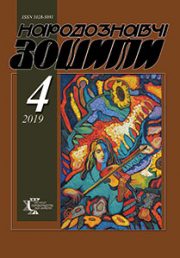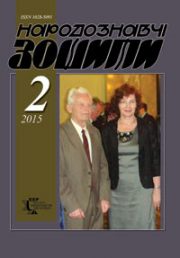The Ethnology Notebooks. 2020. № 3 (153), 512—518
UDK 398″194/196″:393.15
DOI https://doi.org/10.15407/nz2020.03.512
DEMEDYUK Мaryna
ORCID ID: https://orcid.org/0000-0003-4415-002X
Candidate of philology sciences (Ph.D. in philology),
Researcher at the Institute of Ethnology
of the National Academy of Sciences of Ukraine,
Dement of Folkloristic,
15, Svobody Avenue, 79000, Lviv, Ukraine,
Contacts: e-mail: mdemedyuk@gmail.com
Abstract. In the article finding out the basic factors for preserving and strengthening the traditional folk culture, ethnic and national identity of Ukrainians in the context of globalization through careful disclosure of foreigners’ images in the folklore narratives of the events of the Second World War in Volyn Polissya. The purpose of the proposed intelligence is to research the specifics of a non-ethnic hero during the Second World War, which is actualized in the images of a Pole, Jew, German, and Hungarian. The object of the study is the folklore narrative of Volyn Polissya, and the subject is the reflection in the texts of the specific image of a stranger in wartime. The methodological basis of the work is the principles of objectivity and historicism of folklore, and the basic methods — structural and typological method of conceptual analysis. The methodology of Ukrainian and foreign historians and researchers of folk prose (V. Sergiychuk, I. Pashuk, O. Britsyna, etc.) was used. To form the source base, folklore expeditions were conducted, during which material was fixed by means of oral questioning of the respondents according to a pre-prepared questionnaire. Reproduction of ethnic conflicts and participation in the narratives of Volyn Polissya is insufficiently covered in special scientific studies. This aspect is covered quite briefly by the authors without proper analysis, so the basis of the work is the author’s field materials.
In the article, for the first time, we trace the images of non-ethnic characters in folklore prose about the events of the 40—60s of the twentieth century. The role of historical circumstances and interethnic contacts, their differentiation depending on changes of historical realities are emphasized. It has been proven that ethnically alien characters can acquire positive or negative markings depending on the situation. German SS soldiers are depicted as hostile and criminal. The positive role of justice inherent in German soldiers of the regular army, who do not punish those who maintain order, is emphasized. Hungarians are treated negatively as servants of the Nazis. Images of Poles acquire mostly a negative color. The readiness of Poles to cooperate with both the Germans and the Soviet partisans to achieve their goal and repel the singers is clearly emphasized and condemned. The change of accents is characteristic of the image of the Jews. The image of suffering, mass executions of members of this community comes to the fore. The leading role of the universal values of goodness, charity, and self-sacrifice, which play an important role in the portrayal of a positively labeled non-ethnic character, has been proved.
Keywords: non-ethnic character, political situation, folklore prose, image of a foreigner, interethnic conflict.
Received 19.05.2020
REFERENCES
Serhiychuk, V.I. (2003). The tragedy of Volyn: Causes and course of the Polish-Ukrainian conflict during the Second World War. Kyiv: Ukr. Vyd. Spilka [in Ukrainian].
Antonyuk, Ya. (2007). Activities of the OUN Security Council in Volyn. Lutsk: Volyn [in Ukrainian].
Kalishchuk, O. (2010—2011). The problem of Ukrainian-Polish confrontation in Western Ukraine during the Second World War in historical science: a demographic cut. Ukraine-Poland: historical heritage and public consciousness (Vyp. 3—4, pp. 292—306) [in Ukrainian].
Hulay, V. (2006). Ethnopolitical conflicts and ethnic mobilization in Western Ukraine during the Second World War. Ukrainian national idea: realities and prospects of development: collection of scientific works (Vyp. 18, pp. 81—86). Lviv [in Ukrainian].
Pushchuk, I. (2009). The tragedy of the Ukrainian-Polish confrontation in Volhynia in 1938—1944. Rozhysche and Manevychi districts. Luts’k [in Ukrainian].
Silets’kyy, Yu. (2009). Ethnic heterostereotypes in the traditional worldview of the Ukrainians: аbstract of the dissertation of the candidate of historical sciences. Lviv [in Ukrainian].
Nikolayets, Yu. (2017). National minorities of Ukraine during the Second World War in the context of ethnopolitical practices of the warring parties: scientific discourse. Scientific notes of the Institute of Political and Ethnonational Studies. IF Kuras NAS of Ukraine (Vyp. 5—6, pp. 321—368). Kyiv [in Ukrainian].







